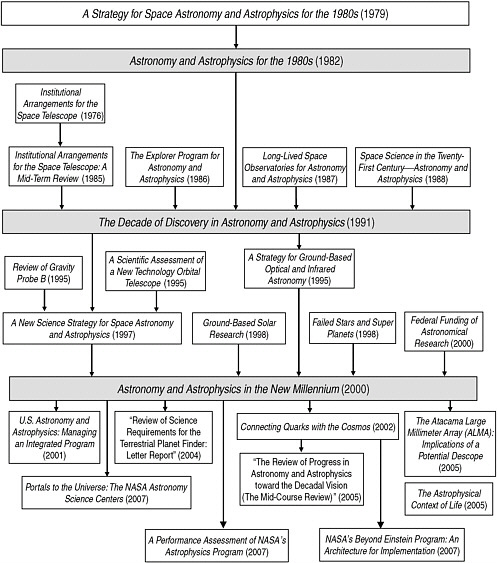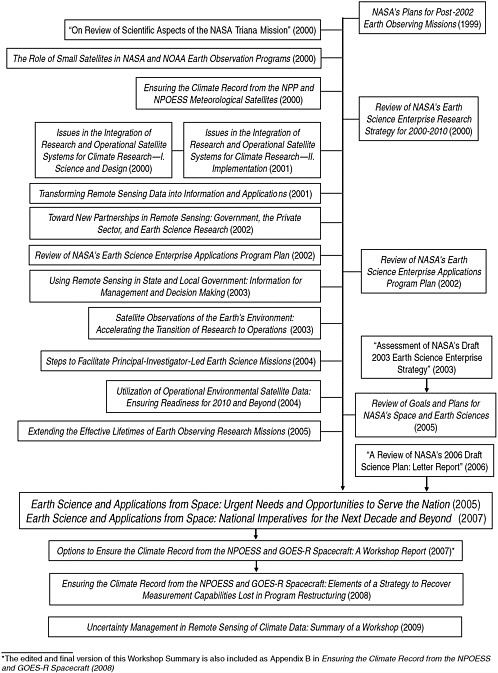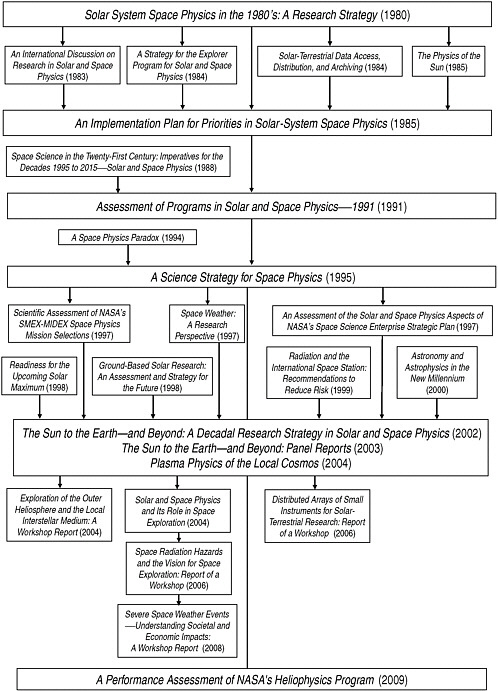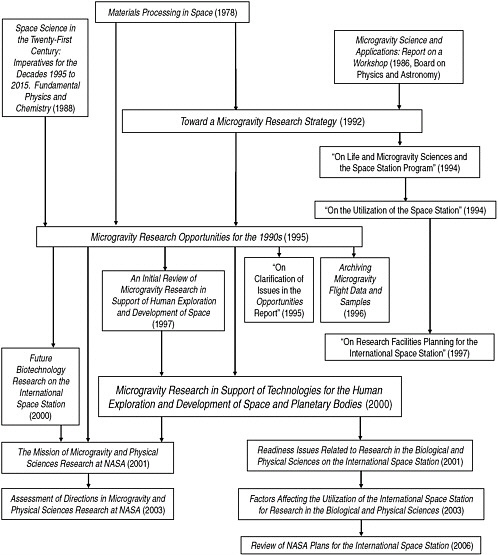2
Board and Standing Committees: Activities and Membership
During 2009, the Space Studies Board (SSB) had five standing committees representing various disciplines: the Committee on Astronomy and Astrophysics (CAA; jointly with the Board on Physics and Astronomy, BPA), the Committee on Earth Studies (CES), the Committee on the Origins and Evolution of Life (COEL; jointly with the Board on Life Sciences), the Committee on Planetary and Lunar Exploration (COMPLEX), and the Committee on Solar and Space Physics (CSSP). The Board and its standing committees provide strategic direction and oversee activities of ad hoc study committees (see Chapter 3), interact with sponsors, and serve as a communications conduit between the government and the scientific community. They do not provide formal advice and recommendations, and therefore are not subject to the Federal Advisory Committee Act, Section 15.
SPACE STUDIES BOARD
HIGHLIGHTS OF SPACE STUDIES BOARD ACTIVITIES
The Board held its 158th meeting on May 13-15, 2009, in Washington D.C. The first day of the meeting was a joint session with the Aeronautics and Space Engineering Board (ASEB) devoted to the fiscal year (FY) 2010 budgets of the agencies. Guest speakers included Chris Scolese, NASA associate administrator (and acting administrator at the time of the meeting); Gale Allen, NASA Exploration Systems Mission Directorate; Lynn Cline, NASA Space Operations Mission Directorate; Robie Samanta Roy, Office of Science and Technology Policy; Paul Shawcross, Office of Management and Budget; and congressional staff, including Jeff Bingham, Ed Feddeman, Chan Lieu, and Dick Obermann. On the second day, the SSB continued the discussion about FY 2010 budgets with Charles Gay, NASA Science Mission Directorate (SMD); Mary Kicza, NOAA-NESDIS; and Richard Behnke, National Science Foundation. The third day included a presentation and discussion about optical communications with John Rush, director of systems planning, NASA Space Communications Office.
The SSB executive committee (XCOM) met on August 4-5 at the J. Erik Jonsson Woods Hole Center in Woods Hole, Massachusetts, for its annual strategic planning session. The XCOM meet with Jean Pierre Swings (European Space Science Committee Chair) and Jean-Claude Worms (European Science Foundation) for a discussion on emerging space powers. The committee also received status reports from Steve Squyres, chair of the Planetary Science Decadal Survey, and Betsy Cantwell, chair of the Decadal Survey on Biological and Physical Sciences in Space.
The Board met at the National Academies’ Arnold and Mabel Beckman Center in Irvine, California, November 3-4. The major focus of the meeting was the Augustine Commission Report with briefings from Commission members Ed Crawley (Massachusetts Institute of Technology) and Jeff Greason (XCOR Aerospace). In addition, David Bearden (Aerospace Corporation) reviewed the cost estimate methodology used by the Commis-
sion. The Board also heard congressional views of the Commission’s report from Chan Lieu and Jeff Bingham of the Senate Commerce Committee and Dick Obermann of the House Science Committee. The Board was also briefed by Mark Uhran (NASA) on the enhanced utilization plan for the International Space Station. The workshop originally planned for this meeting was rescheduled for November 2010. It was the opinion of the planning committee that inadequate time was available this year to organize a workshop on the selected theme that would be the desired caliber.
SPACE STUDIES BOARD MEMBERSHIP
Charles F. Kennel, University of California, San Diego (chair)
A. Thomas Young, Lockheed Martin Corporation (retired) (vice chair)
Daniel N. Baker, University of Colorado at Boulder
Steven J. Battel, Battel Engineering
Charles L. Bennett, Johns Hopkins University
Yvonne C. Brill, Aerospace Consultant
Elizabeth R. Cantwell, Oak Ridge National Laboratory
Dr. Andrew B. Christensen, Dixie State College
Alan Dressler, Observatories of the Carnegie Institution
Jack D. Fellows, University Corporation for Atmospheric Research
Fiona A. Harrison, California Institute of Technology
Joan Johnson-Freese, Naval War College
Klaus Keil, University of Hawaii
Molly K. Macauley, Resources for the Future, Inc.
Berrien Moore III, Climate Central
Robert T. Pappalardo, Jet Propulsion Laboratory, California Institute of Technology
James A. Pawelczyk, Pennsylvania State University
Soroosh Sorooshian, University of California, Irvine
Joan Vernikos, Thirdage LLC
Joseph F. Veverka, Cornell University
Warren M. Washington, National Center for Atmospheric Research
Charles E. Woodward, University of Minnesota
Ellen G. Zweibel, University of Wisconsin
Ex Officio and Liaison Members
Raymond S. Colladay, Lockheed Martin Astronautics (retired) (ex officio, chair, NRC Aeronautics and Space Engineering Board)
Jay S. Pearlman, IEEE (ex officio, member of the NRC Ocean Studies Board)
Edward C. Stone, California Institute of Technology (liaison, U.S. representative to COSPAR)
Jean-Pierre Swings, Université de Liège (liaison, chair of the European Space Science Committee)
Membership of the 2006 SSB Executive Committee
July 1, 2008–June 30, 2009
Charles F. Kennel, University of California, San Diego (chair)
A. Thomas Young, Lockheed Martin Corporation (retired) (vice chair)
Daniel N. Baker, University of Colorado, Boulder
Charles L. Bennett, Johns Hopkins University
Molly K. Macauley, Resources for the Future, Inc.
Berrien Moore III, University of New Hampshire
Robert T. Pappalardo, Jet Propulsion Laboratory, California Institute of Technology
James A. Pawelczyk, Pennsylvania State University
Joseph F. Veverka, Cornell University
July 1, 2009–June 30, 2010
Charles F. Kennel, University of California, San Diego (chair)
A. Thomas Young, Lockheed Martin Corporation (retired) (vice chair)
Daniel N. Baker, University of Colorado, Boulder
Charles L. Bennett, Johns Hopkins University
Molly K. Macauley, Resources for the Future, Inc.
Berrien Moore III, University of New Hampshire
Robert T. Pappalardo, Jet Propulsion Laboratory, California Institute of Technology
Joan Vernikos, Thirdage LLC
Joseph F. Veverka, Cornell University
Staff in 2009
Marcia S. Smith, Director (left the SSB on March 1)
Richard E. Rowberg, Interim Board Director (as of March 2)
Brant L. Sponberg, Associate Director and Senior Program Officer
Joseph K. Alexander, Senior Program Officer
Arthur A. Charo, Senior Program Officer
Sandra J. Graham, Senior Program Officer
Ian W. Pryke, Senior Program Officer
Robert L. Riemer,† Senior Program Officer, BPA
David H. Smith, Senior Program Officer
John Wendt,† Senior Program Officer, ASEB
Dwayne A. Day, Program Officer
Brian D. Dewhurst,† Program Officer, ASEB (left the ASEB in August)
Paul Jackson,† Program Officer, ASEB
David Lang,† Program Officer, BPA
Abigail A. Sheffer, Associate Program Officer (promoted in December)
Lewis Groswald, Research Associate (promoted in May)
Victoria Swisher, Research Associate (left the SSB in August)
Celeste A. Naylor, Information Management Associate (promoted in January)
Tanja Pilzak, Manager, Program Operations
Christina O. Shipman, Financial Officer
Sandra Wilson, Financial Assistant
Catherine A. Gruber, Editor (promoted in March)
Carmela J. Chamberlain, Administrative Coordinator (promoted in March)
Theresa M. Fisher, Program Associate (retired in May)
Andrea Rebholz,† Program Associate, ASEB
Dionna Williams, Program Associate (joined SSB in June)
Terri Baker, Senior Program Assistant (joined SSB in June)
Rodney N. Howard, Senior Program Assistant
Linda M. Walker, Senior Project Assistant
Consultants
Regina North (joined SSB in February)
Space Policy Interns
Elena Amador, Autumn 2009 Lloyd V. Berkner Space Policy Intern
Jordan Bock, Summer 2009 Lloyd V. Berkner Space Policy Intern
Abigail Fraeman, Space Policy Intern
Abigail A. Sheffer, Fall 2009 Christine Mirzayan Science and Technology Policy Graduate Fellow
Angie Wolfgang, Summer 2009 Lloyd V. Berkner Space Policy Intern
U.S. NATIONAL COMMITTEE FOR COSPAR
The Committee on Space Research (COSPAR) of the International Council of Science held its annual business meetings in Paris on March 16-19, 2009. The next COSPAR scientific assemblies will take place in Bremen, Germany, on July 18-25, 2010, and Mysore, India, on July 15-22, 2014. Annual business meetings will be held at COSPAR’s Paris headquarters on March 22-25, 2010.
The membership term of Edward Stone, the current U.S. representative to COSPAR ends in 2010. The SSB, acting in its role as the U.S. National Committee for COSPAR, nominated Robert Lin of the University of California, Berkeley, as the new U.S. representative. The NRC’s Executive Office ratified the nomination, and Dr. Lin will take over his new role on July 1, 2010.
Edward C. Stone, California Institute of Technology (U.S. Representative to COSPAR)
David H. Smith, Senior Program Officer, SSB (Executive Secretary for COSPAR)
Carmela J. Chamberlain, Administrative Coordinator, SSB
STANDING COMMITTEES
COMMITTEE ON ASTRONOMY AND ASTROPHYSICS
The Committee on Astronomy and Astrophysics, which operates under the joint auspices of the SSB and the BPA, continued to be on hiatus until the completion of the astronomy and astrophysics decadal survey. A historical summary of reports from CAA and related committees is presented in Figure 2.1.
David Lang, Program Officer, BPA (from September)
Brian D. Dewhurst, Program Officer, ASEB (through August)
COMMITTEE ON EARTH STUDIES
The Committee on Earth Studies did not meet during the first quarter. The committee met on April 16-17, 2009, in Washington, D.C., at the National Academies’ Keck Center. Highlights of the meeting included updates on activities at NASA’s Earth Science Division and at National Oceanic and Atmospheric Administration (NOAA) National Environmental Satellite, Data and Information Service (NESDIS), which were provided by NASA Earth Science Division director Michael Freilich and NOAA assistant administrator for satellite and information services, Mary Kicza, respectively; a videoconference with Dan Baker and Peter Pilewskie from the University of Colorado on the potential role of small satellites in Earth observations; a discussion with Ed Crawley from MIT, who has developed a modeling tool that can be used to optimize investments in the 2007 Earth science and applications from space decadal survey; an update on GEOSS and CEOS activities, which was presented by committee member Jay Pearlman; a discussion with University of Wisconsin researcher Hank Revercomb on prospects for restoring sounding capabilities in next-generation GOES satellites; and updates on several prospective and ongoing NRC studies. The committee is currently engaged in follow-up discussions with NASA and NOAA on potential ad hoc studies or workshops that would be of mutual interest.
Several members of the committee participated in the June 15-16, 2009, workshop “Geoengineering Options to Respond to Climate Change: Steps to Establish a Research Agenda,” which was organized by CES staff officer Art Charo. The workshop brought some 120 scientists, engineers, philosophers, political scientists, economists, and policy experts together to examine proposed “geoengineering” approaches, or interventions in the climate system,
with an emphasis on the research needed to better understand the potential efficacy and consequences of the various approaches. Information from the workshop is being used to inform the work of the NRC’s “America’s Climate Choices” (http://americasclimatechoices.org) panels and steering committee.
CES met on October 19-20 in Washington, D.C., and received briefings from Mary Kicza, NOAA assistant administrator for satellite and information services, and from Michael Freilich, director of NASA’s Earth Science Division. Committee discussions focused on issues related to the implementation of the 2007 decadal survey, Earth Science and Applications from Space, the status of the National Polar-orbiting Operational Environmental Satellite System (NPOESS), and potential workshops or studies of interest to agency sponsors. The committee also received updates on several prospective and ongoing NRC studies.
Members of the committee and staff have also participated in the development of a study, “Assessing Requirements for Sustained Ocean Color Research and Operations,” which is being led by the NRC’s Ocean Studies Board and several members and staff are participating in this study and “America’s Climate Choices.” The chair of the committee, Berrien Moore, presented testimony before the Subcommittee on Space and Aeronautics of the House Committee on Science and Technology on June 18, 2009, for a hearing entitled, “Opportunities and Challenges for NASA Science Programs.” Committee member Antonio Busalacchi, Jr., testified on March 18, 2009, at a hearing entitled “Critical Satellite Climate Change Datasets” before the Subcommittee on Commerce, Justice, Science and Related Agencies of the House Committee on Appropriations. Members of the committee and staff also appeared in a number of forums to discuss issues related to implementation of the decadal survey.
A historical summary of reports from CES and related committees is presented in Figure 2.2.
Membership
Berrien Moore III, Climate Central (chair)
Ruth S. DeFries, Columbia University (vice chair)
Mark R. Abbott, Oregon State University
Richard A. Anthes, University Corporation for Atmospheric Research
Philip E. Ardanuy, Raytheon Information Solutions
Steven J. Battel, Battel Engineering
Antonio J. Busalacchi, Jr., University of Maryland, College Park
Heidi M. Dierssen, University of Connecticut, Avery Point
Hung-Lung Allen Huang, University of Wisconsin, Madison
Anne W. Nolin, Oregon State University
Jay S. Pearlman, Institute for Electrical and Electronics Engineers, Inc.
Thomas H. Vonder Haar, Colorado State University
Staff
Arthur A. Charo, Senior Program Officer, SSB
Theresa M. Fisher, Program Associate, SSB (through May)
Dionna Williams, Program Associate, SSB (from June)
COMMITTEE ON THE ORIGINS AND EVOLUTION OF LIFE
The Committee on the Origins and Evolution of Life, which operates under the joint auspices of the SSB and the Board on Life Sciences, began 2009 with a major membership rotation to replace those individuals whose terms ended in 2008. Six new appointments were made, including that of J. Gregory Ferry (Pennsylvania State University), who was named the committee’s new life-sciences co-chair. COEL held its first meeting of 2009 at the National Academies’ Keck Center in Washington, D.C., on February 18-20, 2009. The meeting was primarily devoted to various aspects of the NASA Astrobiology Institute’s (NAI’s) activities, including presentations from Mary Voytek, acting director of NASA’s Astrobiology Program; Carl Pilcher, director of the NAI; and the principal investigators of the NAI teams at the Carnegie Institution of Washington, the Georgia Institute of Technology, and the New York Center for Astrobiology. In addition, COEL was briefed on the process being used to identify the landing site for the Mars Science Laboratory and on the outcome of the NASA-European Space Agency prioritiza-
tion process for the outer solar system flagship missions. Finally, the committee heard a presentation from Frances Westall, COEL’s liaison with the European Space Science Committee, on the challenges of searching for traces of life in 3.5-billion-year-old rocks on Earth.
Although COEL did not meet during the second quarter, the committee was engaged in defining a potential task related to planetary protection measures for spacecraft missions to the icy bodies of the outer solar system. The committee is also encouraging members of the astrobiology community to draft white papers to support the goals of the Planetary Science Decadal Survey.
The committee met in Big Sky, Montana, on September 1-3 in order to allow for a site visit to Yellowstone National Park where the committee visited Lower Geyser Basin and Old Faithful. The committee also heard presentations from several local research groups, including the Idaho National Laboratory and Montana State University’s NAI teams and the Thermal Biology Institute. In addition, the committee heard about the latest developments in NASA’s Astrobiology program and the NAI. Finally, the committee heard several presentations relating to planetary protection issues for icy solar system satellites.
COEL did not meet during the fourth quarter, as the December meeting was cancelled and replaced by a conference call held on December 3. In support of a potential future study project, a subset of committee members, including co-chair Robert Pappalardo, and committee staff participated in COSPAR’s Icy Satellites Planetary Protection Workshop, held at the California Institute of Technology on December 9-10.
A historical summary of reports from COEL and related committees is presented in Figure 2.3.
Membership
July 1, 2008–June 30, 2009
Kenneth H. Nealson,† University of Southern California (co-chair)
Robert T. Pappalardo, Jet Propulsion Laboratory, California Institute of Technology (co-chair)
Stanley M. Awramik, University of California, Santa Barbara
Paul G. Falkowski, Rutgers, The State University of New Jersey
Antonio Lazcano, Universidad Nacional Autonoma de Mexico
Ralph D. Lorenz, Johns Hopkins University, Applied Physics Laboratory
John C. Priscu, Montana State University
Sara Seager, Massachusetts Institute of Technology
Everett Shock, Arizona State University
July 1, 2009–June 30, 2010
J. Gregory Ferry,* Pennsylvania State University (co-chair)
Robert T. Pappalardo, Jet Propulsion Laboratory, California Institute of Technology (co-chair)
Stanley M. Awramik, University of California, Santa Barbara
Katrina J. Edwards,* University of Southern California
Paul G. Falkowski, Rutgers, The State University of New Jersey
Margo G. Haygood,* University of Colorado, Boulder
Dante Lauretta,* University of Arizona
Antonio Lazcano, Universidad Nacional Autonoma de Mexico
Ralph D. Lorenz, Johns Hopkins University, Applied Physics Laboratory
Jeff Moersch,* University of Tennessee, Knoxville
John C. Priscu, Montana State University
Sara Seager, Massachusetts Institute of Technology
Barbara Sherwood Lollar, University of Toronto
Everett Shock, Arizona State University
Cristina Takacs-Vesbach,* University of New Mexico
Staff
David H. Smith, Senior Program Officer, SSB
Robert L. Riemer, Senior Program Officer, BPA
Rodney N. Howard, Senior Program Assistant, SSB
COMMITTEE ON PLANETARY AND LUNAR EXPLORATION
The Committee on Planetary and Lunar Exploration is on hiatus until the completion of the planetary sciences decadal survey.
A historical summary of reports from COMPLEX and related committees is presented in Figure 2.4.
Staff
Sandra J. Graham, Senior Program Officer, SSB
COMMITTEE ON SOLAR AND SPACE PHYSICS
The Committee on Solar and Space Physics did not meet until the last quarter of the year, although members held several teleconferences and met in smaller groups at professional meetings and other forums. On December 3-4, the committee met in Washington, D.C. The meeting focused on planning for the upcoming solar and space physics (heliophysics) decadal survey, which will get underway in spring 2010. To that end, the committee received briefings from Richard Behnke, director of the Upper Atmosphere Research Section at the National Science Foundation (NSF); Tom Bogdan, director of NOAA’s Space Weather Prediction Center; and Richard Fisher, director of the Heliophysics Division within NASA’s SMD. NASA, NSF, NOAA, and the Department of Defense (Air Force and Navy) were sponsors of the previous decadal survey in solar and space physics, The Sun to the Earth—and Beyond, which was completed in 2003. The committee was also briefed by Space Studies Board member Andy Christensen, who chaired the recently completed heliophysics roadmap for NASA. Lessons learned from previous and ongoing NRC decadal surveys were discussed during briefings by several staff members of the SSB. As the quarter ended, the committee was engaged in extensive discussions with potential sponsors of the survey regarding its terms of reference, organization, and schedule. The March 3-5, 2010, meeting of the committee in Boulder, Colorado, will finalize plans for survey initiation; following this meeting, the committee will stand down for the duration of the survey.
A historical summary of reports from CSSP and related committees is presented in Figure 2.5.
Membership*
Daniel N. Baker, University of Colorado, chair
Thomas H. Zurbuchen, University of Michigan, vice chair
Joseph F. Fennell, Aerospace Corporation
Maura E. Hagan, National Center for Atmospheric Research
Randy Jokipii, University of Arizona
Krishan Khurana, University of California, Los Angeles
William S. Lewis, Southwest Research Institute
Ramón E. López, University of Texas
Kristina A. Lynch, Dartmouth College
Richard A. Mewaldt, California Institute of Technology
Merav Opher, George Mason University
Howard J. Singer, NOAA Space Environment Center
Ronald E. Turner, ANSER Corporation
Staff
Brant L. Sponberg, Associate Director and Senior Program Officer, SSB
Arthur A. Charo, Senior Program Officer, SSB
Theresa M. Fisher, Program Associate, SSB (through May)
Linda M. Walker, Senior Program Assistant, SSB (from May)
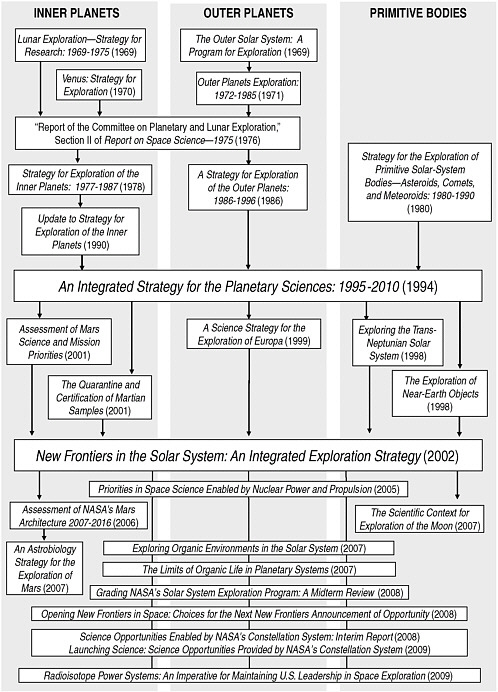
FIGURE 2.4 SSB-NRC advice on solar system exploration (1969-2009). Origins of life topics are covered in Figure 2.3.
SPACE RESEARCH DISCIPLINES WITHOUT STANDING COMMITTEE REPRESENTATION
Although there are no longer standing committees representing microgravity research or space biology and medicine, a life and microgravity decadal survey is being conducted (see Chapter 3). A historical summary of NRC-SSB advice in space biology and medicine is presented in Figure 2.6, and a historical summary of NRC-SSB advice microgravity research is presented in Figure 2.7.
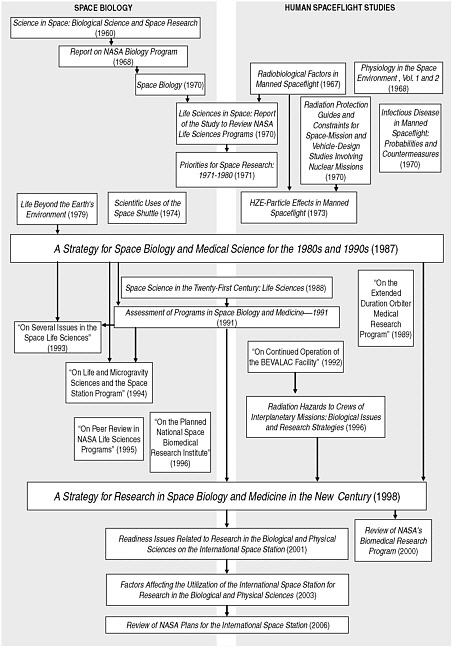
FIGURE 2.6 SSB-NRC advice on space biology and medicine (1960-2006).

